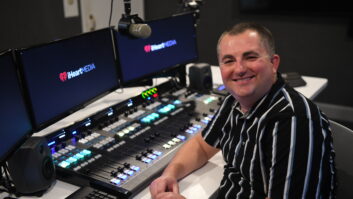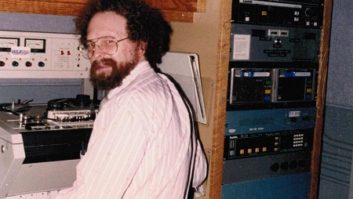(click thumbnail)Citadel DOE Martin Stabbert at a site overlooking Sandia Crest near Albuquerque, N.M. Citadel FMs KRST, KKOB, KMGA and KDRF are among the stations on this tower.RENO, Nev. Citadel is going through an introspective post-merger phase; and its technical department is focused on what it will take to integrate 22 large-market facilities and a radio network into what becomes the third-largest U.S. radio group by station count.
Citadel added ABC’s 14 FM and eight AM radio stations in nine major markets plus the ABC Radio Networks for $2.7 billion. Disney’s ESPN Radio and the Radio Disney Network were not included in the transaction.
With 179 FMs and 66 AMs in 50 markets now under his oversight, Martin Stabbert, director of engineering for Citadel, is looking at the technical needs of the combined entity.
Many analysts agree the merger is a good fit; Citadel and ABC Radio shared no markets. But the challenge will be integrating large-market ABC properties, including facilities in New York, Chicago and Detroit, with Citadel’s collection of stations in medium-sized and small markets.
Stabbert, based in Reno, has visited each ABC Radio market cluster and all ABC Radio Network facilities since Citadel and ABC reached their initial agreement in February 2006. The preliminary evaluation process included inspecting all physical plants and meeting engineering personnel.
“There were really no surprises. We got first-rate facilities in large markets and some engineers who are obviously at the top of their game. The staff that came with the ABC stations are a part of the Citadel family now,” Stabbert said.
‘First-rate facilities’
Stabbert, who has been with Citadel since 1992, admitted there was some anticipation among the former ABC Radio engineers about what would happen. “Their emotions ran the full spectrum, but I think in general there was excitement.”
The transaction was fairly uncomplicated thanks to the lack of duplication in markets, Stabbert said. Hence, no engineering positions have been eliminated within the new company.
“I think people overestimated the difficulty of doing this. I’ve been through small acquisitions that were a lot more complicated where we had to integrate stations into existing facilities in some markets. We basically were getting turnkey facilities in this deal when it came to the physical plant level,” Stabbert said.
Clay Steely, former vice president of engineering for ABC Radio, chose to remain with Disney to work with its O&Os. Steely was “very involved in the transition process as a facilitator,” Stabbert said.
Christine Ianuzzi, vice president for broadcasting, technology, engineering and operations at ABC Radio Networks, transitioned to Citadel as vice president of engineering and operations for ABC Radio Networks, which has facilities in New York and Dallas.
Citadel’s engineering department consists of Stabbert at the top and approximately 50 chief engineers in individual markets supported by additional engineering staff at the station level. There are no regional levels of engineering management, he said.
Some analysts have pointed to a “cultural difference” between Citadel and ABC Radio as an obstacle for management to overcome. Stabbert said there will be a period of adjustment for all involved — “certainly, given that the incoming markets were top 10 markets, with one exception. Some of our legacy markets are a ways down the list. So there are certainly differences in philosophy … maybe not philosophy, but there have to be differences on how things are run.”
Challenges moving forward
“It presents an interesting and perhaps challenging gradient that is more of a pronounced gradient than you would typically have between larger and smaller markets within a group. It’s a bit early to determine what sort of equilibrium will be struck,” he said.
“We have stations in the number one market to unranked markets like Presque Isle, Maine. So you can’t run them the same. The real challenge moving forward will be being able to finesse that unequal treatment for markets that are so different. And unequal sounds negative, but I can’t think of a better way to describe it. We have some very simple, low-impact transmitter installations located on a hill in Maine and Utah.”
But, he said, the company also has facilities on the Empire State Building in New York.
“You can’t expect to drive your truck to the door on the 102nd floor at the Sears Tower in Chicago. Things are very different from market to market.”
Stabbert described the ABC Radio facilities as being consistent with the stature of the markets and the legacy of ABC Radio; he doesn’t expect to make any major equipment overhauls.
“What they have for equipment appears to be working well for those stations. As a general rule we do not like to walk in and make wholesale changes. It would be counterproductive to get rid of perfectly good equipment,” he said.
In the days following the merger, Stabbert said his primary focus is to “keep things running smoothly as we cross the transition threshold” and to “keep current ABC Radio projects in motion,” including several HD Radio rollouts.
Of the 22 ABC Radio stations Citadel acquired, 18 are broadcasting in HD Radio and another three are in various stages of conversion, Stabbert said. Citadel has 31 HD-R stations completed and another four under conversion.
Citadel, which doesn’t have standardized purchase agreements in place with any equipment manufacturers, has purchased more IBOC gear from Harris than from any other equipment manufacturer, Stabbert said. However, it also has purchased HD-R transmitters from Nautel, Broadcast Electronics and Continental in the past.
Evaluation process
Stabbert said the post-merger assessment will continue for the conceivable future with the possibility of subtle changes being made in how the company’s 50 or so market engineering managers conduct company business.
“It’s still very early in the process, but I expect no major philosophical changes to be made at this point,” he said.
Whether immediate operational changes are implemented, corporate-level engineers with large broadcast groups said the potential for culture shock exists for the former ABC Radio employees.
“I expect some of the ABC folks will be shocked when confronted with their new budgets and staffing expectations, a bit like what Susquehanna employees went through following the Cumulus merger,” one source said.
Stabbert declined to discuss Citadel’s estimated post-merger engineering budget with RW.
Another source, familiar with the management styles of both ABC Radio and Citadel, described Citadel’s style of operating as “very economical.”
“The (ABC Radio) physical plants are among some of the finest in the business with generous funding provided for operational and capital projects. That is likely to change at least a bit,” he noted.
A third corporate engineering manager suggested Citadel would likely do an in-depth analysis to see if it can reduce operating costs.
“Lots of analysis and financial and programming data crunching will be involved,” he said.
Yet another engineering manager who has been through several mergers, said, “The first challenge is to how to keep from losing any great engineers during the transition. There is always a period of uncertainty during transition and it is at that time that people start looking for other opportunities. An open dialogue and communication in the months following the merger is key.
“Management shouldn’t favor incumbents. Rather, the individuals best suited for any given position should be given that position, regardless of which side of the fence they came from,” he said.
Comment on this or any story. E-mail [email protected].












